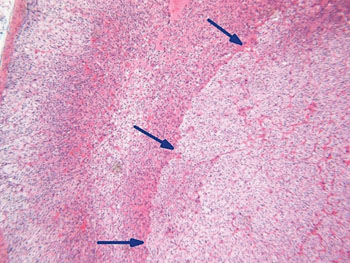Novel Urinary Biomarkers May Indicate Adrenal Cancer
By LabMedica International staff writers
Posted on 20 Oct 2015
A global analysis of metabolites and small molecules in urine samples from patients with adrenal cancer has identified four biochemicals that, when measured together, can distinguish malignant from benign adrenal tumors.Posted on 20 Oct 2015
This analysis may help surgeons more confidently decide how to treat patients who have signs of adrenal masses on radiologic imaging but no symptoms of adrenal disease. Such patients are considered to have adrenal incidentalomas. Adrenal incidentalomas are the most common type of abnormality discovered on imaging studies that are performed for conditions unrelated to the adrenal gland.

Image: Histopathology of an adrenal incidentaloma showing the pushing border between the adenoma and the surrounding parenchyma (arrows) (Photo courtesy of the Government of Western Australia).
Scientists at the US National Institutes of Health (NIH; Bethesda, MD, USA) obtained urine specimens from 19 patients with adrenal cortical carcinoma and 46 patients with benign adrenal tumors and ran a global analysis of all metabolites to detect differences in the two groups. A total of 67 biochemical features discriminated cancer from benign tumors in these samples, but only four specific metabolites could be considered as biomarkers for cancer: creatinine riboside, tryptophan, Nε, Nε, Nε-trimethyllysine, and 3-methylhistidine.
When these metabolites were present in characteristic patterns in urine samples, they were highly sensitive and specific for carcinoma. The metabolites could successfully identify cancer in 94.7% of cases and rule out the disease 82.6 % of the time. In comparison, adrenal lesions greater than 4 cm in diameter have a sensitivity of 93% and a specificity of only 42% for cancer. The study also found that the four metabolites had a high likelihood of predicting which patients had cancer and which did not. The positive predictive rate was 69.2, and the negative predictive rate was 97.4.
Dhaval Patel, MD, a staff clinician at the NIH, said, “Up until now, there have been no metabolomic markers to tell us whether an adrenal lesion is cancerous or not. Scientists have done metabolic studies in patients with adrenal cancer, but they have looked at larger molecules, and they have targeted their investigations at specific steroids or gene profiles. This is the first untargeted global look at all metabolites and molecules smaller than 800 Dalton. When surgeons see changes in these metabolites, they may be more likely to lean toward surgery for patients with adrenal incidentalomas because the likelihood of malignancy will be much higher.” The study was presented at the Annual Clinical Congress of the American College of Surgeons held October 4–6, 2015, in Chicago (IL, USA).
Related Links:
US National Institutes of Health













